Higher Prices, Smaller Spaces: Correlation Between Apartment Prices and Architectural Practices in Skopje
© 2024 Mihajlo Zinoski, Vebi Fazliu, Valmir Dalipi, et al. This is an open-access article distributed under the terms of the Creative Commons Attribution License, which permits unrestricted use, distribution, and reproduction in any medium, provided the original author and source are credited.
Abstract
Problem Statement: The post-pandemic real estate market in Skopje has drastically altered apartment layouts. As apartment prices continue to rise, apartment sizes continue to shrink. The sudden appearance of unusual apartment layouts must be studied as phenomena of built space as evidence of architectural transformations as commodification (Herbert Marcuse, Commodification theory by Carl Marx According to Marx, Commodification is a process by which exchange value comes to dominate use value. Markets, money, and profit-orientation are instruments that facilitate the subjugation of use value to exchange value). The problem of this research is the reconsideration of the impact of the real estate market on architectural practices when designing apartment buildings, where a building is a product used merely in the real estate business.
Purpose of Study: In the past four years, apartment prices per m2 in the Republic of North Macedonia have increased dramatically (30 - 40%) (independent variable) compared to prior years. The following has resulted to a decrease in the size of apartments (dependent variable). Even though there are regulations relating to the minimum size (qualitative methodology) of apartment spaces, it is widespread to come across apartments with a greater number of rooms in less space. This resulted in new apartment layouts determined exclusively by the real estate market. Through the examination of recently emerging new layouts of residential apartments in Skopje, this paper aims to identify, determine the correlation between real estate market and it’s impact that creates such an approach. This directional hypothesis examine quality of spatial organization as qualitative component in a relation to its size (m2) as quantitative component.
Methods: The research is focused on newly constructed apartment buildings as case study. The research process will investigate and observe the size and layout of newly built and designed apartments.
Findings and Results: The expected findings of this study will suggest that the design process for apartment buildings is entirely dictated by the real estate market, resulting in new apartment layouts that might or might not meet the comfort demands of users.
Conclusions and Recommendations: This research re-presents architecture as one of the contemporary paradigms of the built environment based on the assumption that new apartment layouts offer new opportunities and possibilities for balancing the disparities between customer demand and customer available resources.
Introduction
Skopje is a city that has been affected by the three decades of transition that has impacted all sectors of society, starting with political, economic and social change. All these significant factors had a direct impact on the quality of life in the city, either in a positive or negative way. Once these transitions in political, economic, and social life were put in motion, the architectural practice that used to be determined by socialist standards, tries to respond by attempts to establish contemporary paradigms of the new reality [1].
Effects of globalization and urbanization considerably influence living patterns. This in turn brings about changes in perceptions and preferences. These changes will appear in the housing scenario and it is essential that planners incorporate these changes during initial planning of any housing project [2].
The urban and architectural transformation based on the movement of the transition period penetrated the entire city as a whole, and its influence reached into the smallest urban unit such as houses and apartments. The house or apartment it is the first unit of society and it is the primary unit of human habitation [2]. Until the pre-pandemic period, the prices of apartments in Skopje had increased very slightly, but this changed drastically in the post- pandemic period and has been gradually increasing since then (National Bank of the RN Macedonia, 2023).
The main objective of this work is to determine the correlation between the apartments and their purchase price in the real estate market and how this affects their appearance, leading to a functional and typological transformation of the newly designed and built apartments in the city of Skopje. The architecture, influenced by strong economic reasons, appears as a link between the price and the function of the apartments and, at the same time, as a generator of new typological architectural patterns, which are different from those built in the city of Skopje before the period of transition.
The spatial organization of dwellings changes rapidly and is highly influenced by design trends, region, culture and society. Society and cultural values establish a spatial order in and around living spaces and reflect the characteristics of such spaces. A relation exists between space and human interactions and differences in social systems influence a variety of housing layouts [3].
According to the relevant literature, there is a scientific gap regarding the correlation and influence between the price of a apartment and its functional area. Feng et al., describes that housing with a lower square meter price is subject to greater price competitiveness in the market a maxim that corresponds to apartments also [4]. Spatial layout of the apartment changes according to social and economic periods [5]. Some studies finds strong evidence that location is the strongest determinant affecting apartment prices and that size and floor have the highest positive effect on apartment prices [6]. Another research on housing prices according to hedonic model reveal that water system, pool, type of house, number of rooms, house size, locational characteristic and type of the building are the most significant variables that affect the house prices [7]. Considering this literature background, we can assume that the price, the size of the dwelling and the housing are correlated, but the main objective is to research how these two components such as price and size, managed by real estate agencies and with the help of architectural practices, generate a phenomenon that affects the quality and standards of urban policies and the comfort of users.
Materials and Research Method
In order to determine the influence of real estate on architectural practices in the design of apartments or collective housing complexes, and to show the background of the increasing prices of apartments and the constant reduction of their functional space, we will apply quantitative comparative methods between different apartments and locations in the city of Skopje. The material used for this research was collected from two sources: the first part for the apartments built before the 1990s was taken from the Housing Office of the City of Skopje, 1968-1970 edition, and the second part for the newly built apartments (from 2010 – until nowdays) was collected from various real estate agencies and construction companies in the mentioned sector.
Based on the collected materials, the research focus will be on the two-and three-room apartments, as this is the most developed and used typology in the city of Skopje, and at the same time the type where the functional and morphological transformations that are the aim of this research are very evident. Two examples of apartments built before the 1990s and two examples of apartments built after 2020 were analyzed for each type of apartment. In order to clarify the analysis, the apartments will provide specific results for us through the architectural representation of the layout and interior spaces, as well as the spatial tightness compared to each other. The typical apartments from both periods illustrated in the mutual comparison are representing certain influencing factors, political, social and economic circumstances from the time of their construction.
Two-Room Apartments
A comparative analysis of the plans of the four apartments shows that a two-bedroom apartment built before the 1990s (Figure 1, Figure 2) has major differences in the organization of the space and its function, in contrast to the newer apartments (Figure 3, Figure 4).
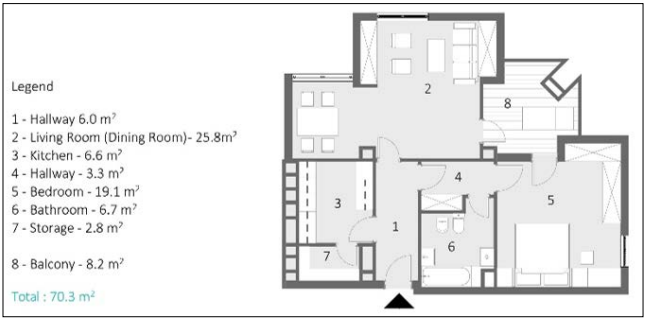
Figure 1: Two-Room Apartment built before the 1990s, source: https://marh.mk/wpcontent/uploads/2017/05/1_Gradski-zid-Skopje.pdfpage16.(07/2023).
Even though the apartments in both examples are basically two- bedroom apartments, the usable space in the newer examples has decreased by about 20 - 25 m2 due to a number of other factors, but economic influences and real estate agencies play the main role.
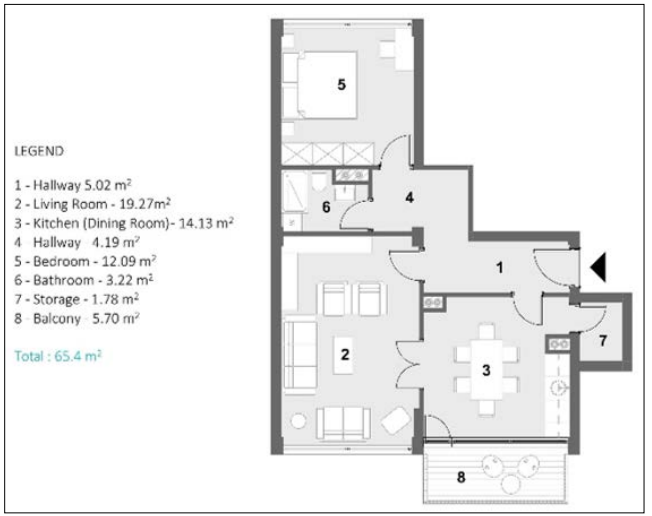
Figure 2: Two-Room Apartment built before the 1990s, source: https://marh.mk/wpcontent/uploads/2017/08/7_Skopje-sever-Cair.pdf(07/2023)page55.
In order to significantly reduce the area of the new apartments, in addition to the unavoidable minimal spaces such as the living room and the bedroom, dedicated spaces such as the kitchen, in some cases the storage and the terraces are completely removed or integrated into the minimal spaces of the living area.
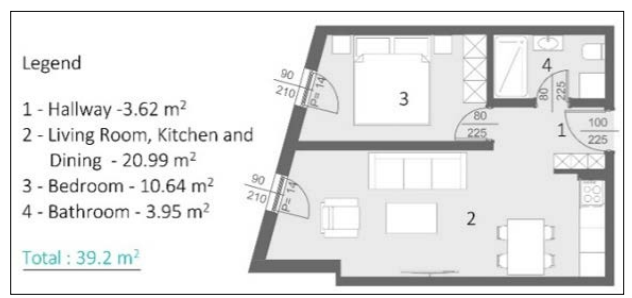
Figure 3: Two-Room Apartment built after 2020 source: https://aquaductresidence.com/d-floor-4/(07/2023).
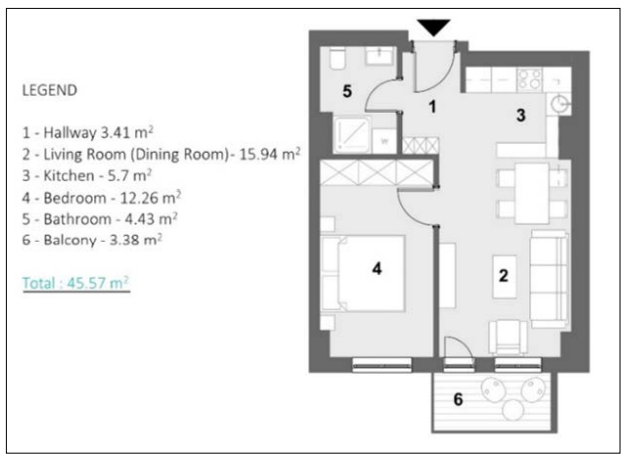
Figure 4: Two-Room Apartment built after 2020 source: https://eastgateliving.mk/en/apartments/a2-2-27/(07/2023).
Three-Room Apartments
Three-room apartments are the most widespread typology in the city of Skopje, as before the 90s and now they are apartments that accommodate mainly four-member families and represent a family type of apartment.
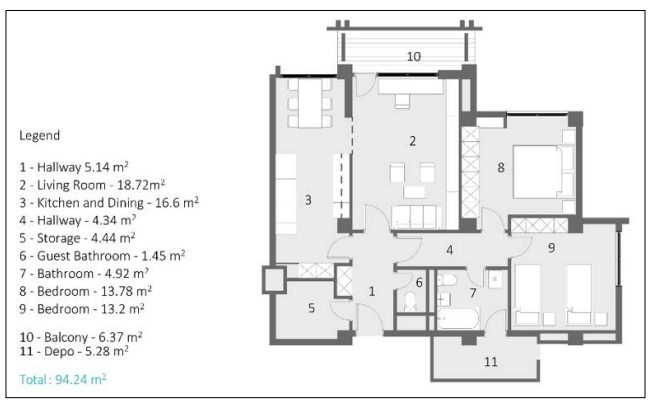
Figure 5: Three-Room Apartment built before the 1990s, source: https://marh.mk/wpcontent/uploads/2017/05/1_Gradski-zid-Skopje.pdfpage19,(07/2023).
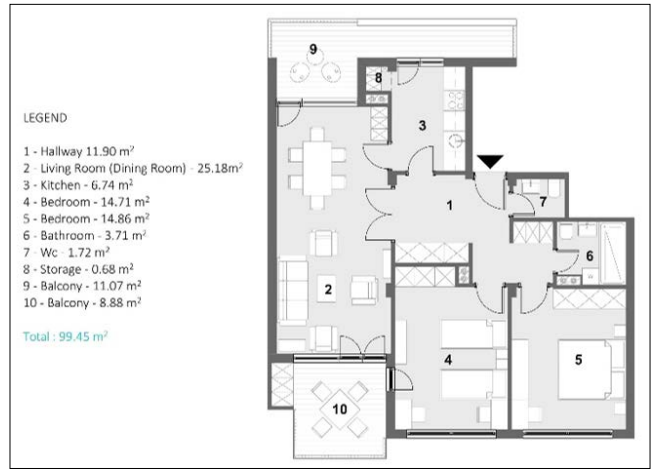
Figure 6: Three-Room Apartment built before the 1990s, source: https://marh.mk/wpcontent/uploads/2017/07/5_Avtokomanda.pdfpage34,(07/2023).
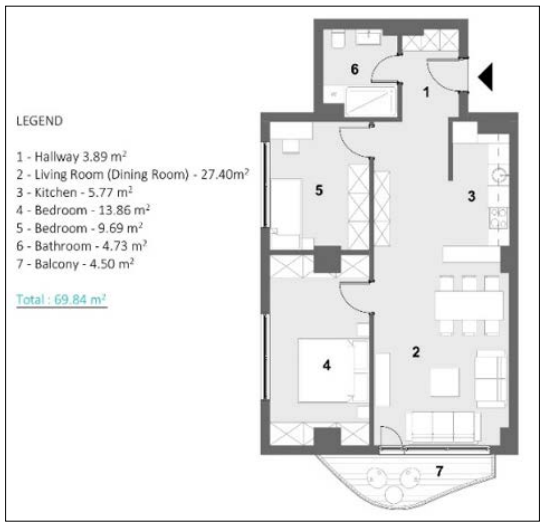
Figure 7: Three-Room Apartment built after 2020, source: https://biholding.mk/wpcontent/uploads/2021/12/BiHolding-Dreamlux.pdf(07/2023).
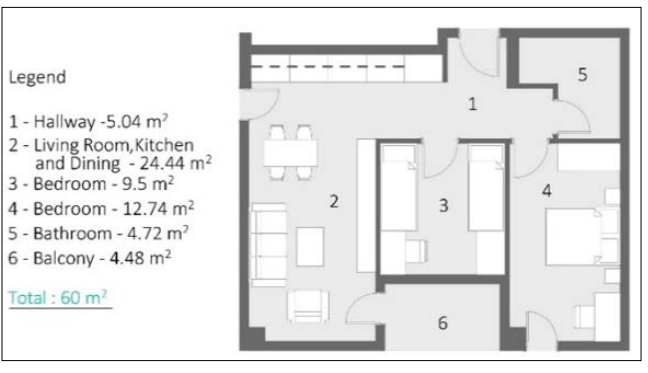
Figure 8: Three-Room Apartment built after 2020 source: https://www.elenalukaengineering.com/blog/portfolio/connect-5/(07/2023).
However, as in the case of two-room apartments, this typology is also being reduced to a minimum over time and under the pressure of economic and real estate prices. In mutual comparison, the floor layouts from the two periods, despite belonging to the same typology, show great differences in functional and spatial comfort. The main spaces such as the living room, dining room and bedrooms are significantly reduced in size, and in many cases this typology of apartments according to the standards requires additional sanitary facilities, etc., which are absent in the new contemporary typologies.
Results
In typologies with two- and three-bedroom apartments in different locations, mostly around the city center of Skopje, in two separate tables 1 and 2 are given the square meters of the apartments and their real estate price. We do not have exact data about the purchase price of the apartments, but we have determined it by referring to real estate agencies and it varies from 1250 euros to 1800 euros per m2 for the above-mentioned locations. We have taken the average price of 1350 euros to compare how the square meter of the apartment has decreased, which is influenced by the price of the same property.
Table 1: Tabular comparison of square meters and the prices of two-room apartments from the two periods before the 1990s and after 2020
|
|
Net square area m2 |
Price per 1 m2 € |
Total price € |
|
Figure 1 |
70.3 |
1350 € |
94 905 € |
|
Figure 2 |
65.4 |
1350 € |
88 250 € |
|
Figure 3 |
39.2 |
1350 € |
52 650 € |
|
Figure 4 |
45.57 |
1350 € |
61 519 € |
|
Difference Sq.area / Price |
20-30 |
1350 € |
27 000 € – 40 500 € |
Table 2: Tabular comparison of square meters and the prices of three-room apartments from the two periods before the 1990s and after 2020
|
|
Net square area m2 |
Price per 1 m2 € |
Total price € |
|
Figure 5 |
94.24 |
1350 € |
127 224 € |
|
Figure 6 |
99.45 |
1350 € |
134 257 € |
|
Figure 7 |
69.84 |
1350 € |
94.284 € |
|
Figure 8 |
60 |
1350 € |
81 000 € |
|
Difference Sq.area / Price |
24.4 – 39.45 |
1350 € |
32 940 € - 53 257 € |
From the tabular statistics, it can be seen that the price of apartments becomes more expensive as the number of square meters increases. There is a big difference between the net square meters of apartments built before the 90s, in the period of socialism, and the buildings built after the 2020 pandemic period. If today we buy an apartment functionally solved with all the standards and norms, like those built before the 90s, be it a three- room or two-room apartment, it can cost more than the real price between 30,000 and 55,000 euros, unlike the apartments that are built today. This increase in the price of apartments has led us to minimize the design standards and floor area of apartments being built and designed in the city of Skopje today.
Conclusions
Looking at the tabulated statistics for two- and three-bedroom apartments in the city of Skopje clearly confirms that the apartments and their functional organization are completely dependent on the real estate market of the city. Real estate agencies and developers of residential complexes are under the pressure of the price increase, which affects the future sale of the same. Larger apartments with high comfort and large living space, such as those built before the 1990s, are much more difficult to sell rapidly, unlike apartments built in the transition period and examples built after 2020, which are easier to sell due to the small amount of square footage available. In almost all cases, the apartments that are sold first in an residential complex are those that offer as many rooms as possible and minimal living space, such as the examples of figures (3, 4, 7 and 8).
Table 3: Price per square meter for apartments in the city of Skopje over the years according to data from the State Statistics Office, source: https://www.stat.gov.mk/PrikaziSoopstenie.aspx?rbrtxt=65 (07.2023).
|
Year |
2005 |
2019 |
2023 |
|
Price per 1 m2 (Euro)€
|
707 Eu |
925 € |
1350 € |
Regarding Table 3, which presents the price growth for a certain period, we find that the price increases the most after the pandemic period from 2020, a data that we can compare with the percentages of the National Bank of R.N. Macedonia, where basic data are given, and from 2020 - 2023, after the pandemic period, the price of apartments has increased by 38.47 percent (National Bank of the RN Macedonia, 2023).
The close and inevitable correlation between real estate agents, residential developers and apartment prices means that the architectural practices with which the whole story begins will continue to be dictated by these factors and will constantly produce new architectural typologies and projects that satisfy all the stakeholders. To meet all the requirements that come first to profit from the pressure to be easier and quicker to be sold, the typology of the apartments is being constantly reduced and with it the comfort and design standards.
References
- Zinoski M, Fazliu V, Brsakoska J, Dalipi V (2022) New Models of Architecture in The Real Estate 7th Conference of Interdisciplinary Research on Real Estate Ankara, Turkey, 2022 Institute of Real Estate Studies, Ljubljana, Slovenia 36-46.
- Kurian SM, Thampuran A (2001) Assessment of Housing Quality. Institute of Town Planners. India Journal 8: 74-85.
- Chohan AH, Bhai Khan Shar, Jihad Awad, Arif Jawaid, Norngainy Mohd Tawil, et al. (2015) A Model of Housing Quality Determinants (HQD) for Affordable Housing. Journal of Construction in Developing Countries 20: 117-136.
- Feng ST, Peng CW, Yang CH, Chen PW (2021) Non-linear relationships between house size and price. International Journal of Strategic Property Management 25: B240-253.
- Brkanic I, Stober D, Mihic M (2018) A Comparative Analysis of the Spatial Configuration of Apartments Built in Osijek, Croatia, between 1930 and Journal of Asian Architecture and Building Engineering 17: 23-30.
- Hoxha V, Hoxha J, Hoxha D (2021) Study of factors influencing apartment prices in Prishtina, International Journal of Housing Markets and Analysis 15: 1242-1258.
- Selim S (2008) Determinants of House Prices in Turkey: A Hedonic Regression Model. Dogus Universitesi Dergisi 9: 65-76.

